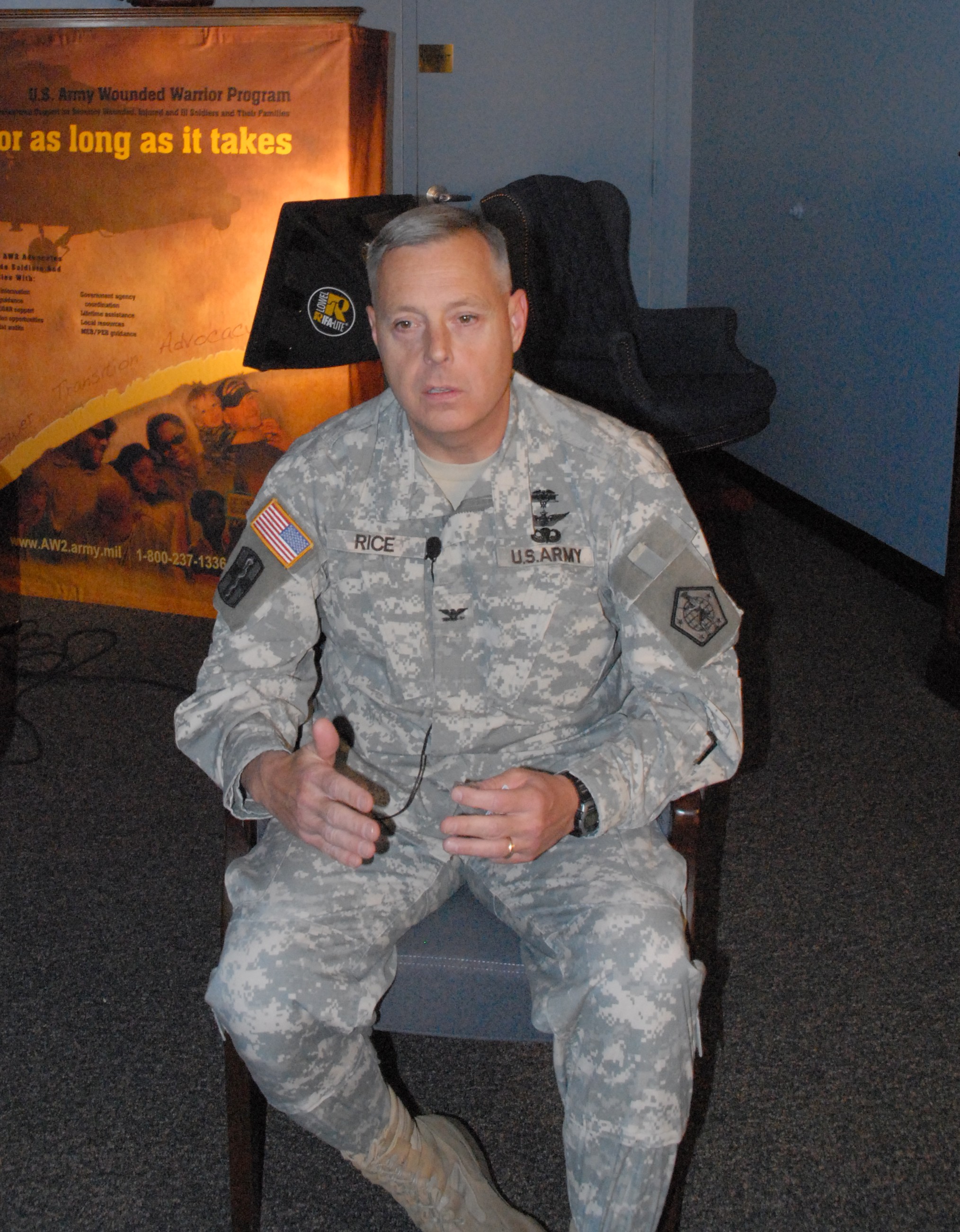WASHINGTON (Army News Service, Oct. 28, 2008) - The Army Wounded Warrior Program has expanded it's criteria so more severely wounded, ill and injured Soldiers can participate, the program's leaders said in an interview Friday.
Program director Col. Jim Rice and Sgt. Maj. Brent Jurgersen said that Soldiers with a combined disability rating of 50 percent will be eligible for the program as long as the injuries are combat-related.
For example, if a Soldier has a 10-percent rating on his hand, 20-percent on his leg and 20-percent due to traumatic brain injury, he would now qualify for AW2 if those injuries were combat-related. In the past, Soldiers were required to have a 30-percent disability rating for a single injury or illness.
"As we were laying out the criteria for the Army Wounded Warrior Program in a briefing for senior leaders, one of the responses was that they thought maybe the program wasn't as inclusive as it needed to be. That they had, in their visits to Army installations, come across Soldiers and families who needed the support of programs like the Army Wounded Warrior Program," said Rice. He and Jurgersen pointed out that those Soldiers may be more in need of assistance than the wounded Soldiers who were traditionally eligible for the program, founded in 2004.
"It is the right decision to make," said Jurgersen. "This population captures what our mission is and that is to take care of the most severely wounded and ill Soldiers and their families. This change in eligibility criteria just kind of capitalizes on that...so we can reach those Soldiers who have that need."
Soldiers with a disability rating of 30 percent for a single injury or illness, whether combat-related or not, remain eligible for the program as well. These Soldiers have typically lost a limb, vision or hearing, have suffered severe burns or have severe post-traumatic stress disorder or traumatic brain injury. About 3,400 Soldiers are currently enrolled in the program.
Newly-eligible Soldiers don't have to do anything to enroll in AW2. The program will contact them, and even if Soldiers and their families don't want to participate or need assistance, program officials said AW2 will keep them on the rolls and periodically check in.
With a ratio of 30 Soldiers and families to one advocate, AW2 can assist Soldiers with everything from finding medical care, to getting disability benefits from Social Security and the Veteran's Administration to finding employment and educational opportunities, said Rice.
Even something as simple as helping Soldiers move can make a huge difference to them, said Jurgersen, who speaks from experience. He became AW2's senior enlisted advisor after two severe combat injuries. After an infection left him temporarily unable to use a prosthetic, AW2 found three college students to help set up his new house.
Jurgersen was wounded in 2004 in Iraq when a bullet ricocheted through his face, his jaw and down his throat. After extensive rehabilitation, he decided to rejoin his unit in Iraq, only to be hit with a rocket-propelled grenade three weeks before they were supposed to return home. The attack killed one Soldier and left Jurgersen with a skull fracture, injuries to his right hand, right leg and enough damage to his left leg to require amputation.
"When I woke up I really thought my life was over as I knew it," he said. "Here's a person who prided himself in his career, his physical fitness and his capabilities of leading Soldiers and just like that it's gone. But you learn. I'll never forget one of the people who walked into my room. He was a double amputee from the Vietnam era. He walked in, and maybe it was the drugs, but I never noticed anything. He sat down and we were talking and he said, 'I'm a double amputee myself.' It kind of made you think."
The program means so much, he said, because Soldiers like him are proud. He said he would never have asked for help if AW2 hadn't recognized he needed some.
"I could tell you stories all day long. I could tell you stories of a young lady I met in California who spent the last four years either in a military hospital, a VA polytrauma hospital or a civilian hospital, who went home for the first time ... She went from being in a coma for six months to walking me out to my car. Those things are great. I met a young man on the same trip. Also, spent the last four years of his life in a hospital or a polytrauma, quadriplegic from the neck down, blows in a tube to move his wheelchair around. But for the first time in his life, he is looking to find a caregiver and an apartment for himself," Jurgersen said.
Both he and Rice pointed out that the AW2 program works with families as well, and in fact that family members are often their primary contacts.
The program is distinct from the Warrior Transition Units around the Army, although about 800 AW2 Soldiers are in WTUs as well. The majority, however, have already transitioned to civilian life, and a small percentage have returned to active duty.




Social Sharing